Posts tagged Skyscraper
Sum Skyscraper
Jan 17th
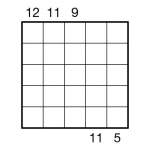
Sum-Skyscraper 5×5 puzzleI made this puzzle just before Christmas, and it’s been waiting on my desktop to be posted here ever since! Well, now it finally has been. ![]()
This is a Sum Skyscraper. Place the digits 1 to 5 once each into every row and column in the grid. Numbers outside the grid provide the total (i.e. sum) of ‘visible’ grid digits along that row or column, if you imagine each digit as a building of that many storeys. Taller buildings always obscure shorter ones. So, for example, a clue for 21354 from the top of such a column would be 10, since the 2, 3 and 5 are visible (the 1 and 4 are obscured by the 2 and 5 respectively), and 2+3+5 = 10.
Sum Skyscraper puzzles
May 14th
Following-up yesterday’s Skyscraper puzzles, I thought I’d post a couple of Sum Skyscraper variant puzzles.
Sum Skyscraper puzzles are very similar to Skyscraper puzzles, so no number can repeat in any row or column and external ’skyscraper’ clues reveal information about the numbers in the main grid. In 5×5 puzzles place 1-5, and in 6×6 puzzles place 1-6.
Each number in the completed grid represents a building of that many storeys, and place the buildings in such a way that each given number outside the grid represents the sum of the number of buildings that can be seen from that point, looking only at that number’s row or column. A building with a higher value always obscures a building with a lower value, while a building with a lower value never obscures a building with a higher value. So the clue ‘6′ in a 5×5 puzzle would indicate that the buildings ‘1′ and ‘5′ can be seen (’5′ is always visible in 5×5 puzzles), so the solution to a row might be 15234.
Skyscraper puzzles
May 13th
I haven’t posted here for a while, but to celebrate the advent of reduced-clue skyscraper puzzles on PuzzleMix.com earlier today I thought I’d post a few Skyscraper puzzles here.
Skyscraper puzzles combine the no-repeat row and column constraints of sudoku with novel additional clues. In these 5×5 puzzles, place the numbers 1-5 once each into every row and column. Each number in the completed grid represents a building of that many storeys.
Place the buildings in such a way that each given number outside the grid represents the number of buildings that can be seen from that point, looking only at that number’s row or column. A building with a higher value always obscures a building with a lower value, while a building with a lower value never obscures a building with a higher value.
Skyscraper puzzles
Mar 16th
I’ve just added Skyscraper puzzle support to Puzzlemix. Hop on over if you’d like to try playing Skyscraper puzzles online!
This means that there are now 16 different types of puzzle on the site, plus a variety of sizes for each of those puzzle types.
Consecutive Skyscraper
Nov 24th
It’s been a while since I posted a new puzzle here, what with all the excitement about Sudoku Xtra magazine, so I thought I had better do something about that right now! So to that end, here’s something a little bit unusual – a Consecutive Skyscraper puzzle.
Now Consecutive Skyscraper may sound like a brief description of downtown Manhattan, but in fact it’s a puzzle with pretty simple rules:
- Place 1 to 8 in each row and column
- Obey the Skyscraper constraints: each number outside the grid reveals the number of ‘visible’ digits looking along that row/column, where higher digits obscure all lower ones
- White bars between squares reveal all consecutive squares – those where the difference is one (such as 1&2, 2&3, etc). Squares without white bars between are not consecutive
If that isn’t detailed enough for you, try clicking the relevant links on the right, or here’s what I wrote back in April about Skyscraper puzzles:
In a Skyscraper puzzle you place numbers in a grid whilst obeying ‘building height’ constraints around the edge. These building height constraints specify the number of notional buildings you could see whilst standing at the edge of the puzzle and looking in, whereby a taller building completely hides the view of any shorter building. The idea is that a digit ‘1′ in the grid is a building 1 storey high; a digit ‘2′ in the grid is a building 2 storeys high, and so on.
If you had a very simple 3×3 Skyscraper puzzle, here’s the potential solutions to each of the possible clues:
- 1: can be either 3 2 1 or 3 1 2, with the ‘3′ hiding both the other digits
- 2: can be 1 3 2 or 2 3 1 or 2 1 3.
- 3: can only be 1 2 3 because this is the only way to see all of the buildings.
Good luck! ![]()
Skyscraper Sudoku 8×8
Jun 19th
Continuing my series of 8×8 Skyscrapers and variants, here’s an 8×8 Sudoku with Skyscraper clues around the edge.
The rules are simple:
- Place 1 to 8 in each row, column and 4×2 box
- Obey the Skyscraper constraints: each number outside the grid reveals the number of ‘visible’ digits looking along that row/column, where higher digits obscure lower ones
Good luck!
Consecutive Skyscraper 8×8
Jun 17th
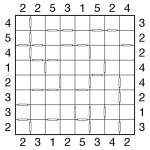
Consecutive Skyscraper 8×8 puzzle
Here’s a combination I haven’t posted before – a standard skyscraper puzzle with the addition of consecutive markers between adjacent squares. This allows the creation of an 8×8 puzzle without needing to also add Sudoku boxes.
The rules are as follows:
- Place 1-8 in each row and column
- Numbers outside the grid reveal the number of ‘visible’ numbers looking along that row/column, where higher numbers obscure lower ones
- White bars between squares reveal all consecutive squares – those where the difference is one
Good luck! ![]()
SSSS: Skyscraper Shuriken Samurai Sudoku
Jun 5th
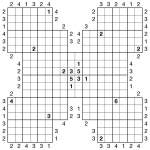
Skyscraper Shuriken Samurai Sudoku puzzle
I’m glad yesterday’s Shuriken Samurai went down well, so today I’ve upgraded it to a Skyscraper puzzle (following Christine’s request for more Skyscrapers!). This is, I think it’s fair to say, quite a bit harder than the basic Samurai yesterday was – but then any puzzle with a title this hard to say quickly really shouldn’t be able to be solved quickly either… ![]()
The rules are the same as yesterday (place 1-6 into each row, column and 2×3 box of the 13 underlying 6×6 Sudoku grids) but with the addition of Skyscraper constraints: place numbers so that the given number of digits can be ’seen’ from each external Skyscraper clue outside the grid. From the vantage point of each Skyscraper clue look along the adjacent row/column – with higher numbers obscuring all lower numbers (or those of the same value), the clue tells you how many numbers are visible. Check back to older puzzles I’ve posted for more detailed help.
Good luck! ![]()
Wrap-around Consecutive 3-grid 6×6 Samurai Skyscraper
May 18th
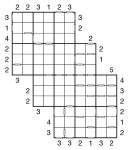
Wrap-around Consecutive 3-grid 6×6 Samurai Skyscraper puzzle
Another mouthful of a puzzle name, but in essence simply a development of the previous puzzle I posted. This time we still have the wrap-around consecutive-ness, but I’ve extended it to a samurai puzzle and added in skyscraper clues. To keep it reasonable, I’ve reduced the underylying Sudoku size to 6×6, however!
What’s particularly fun about the wrap-around markers is that they warp from one side of the puzzle to the same row/column on the opposite side – for the centre two columns this means that they constrain the values of two numbers 10 squares apart.
So the full rules are:
- Place 1 to 6 into each row, column and 2×3 bold-lined box of each of the three underlying 6×6 grids
- White bars show that adjacent cells are consecutive – i.e. 1&2, 2&3, 3&4, 4&5 or 5&6; those squares without a white bar between are non-consecutive
- White bars are shown where appropriate even on the edges of the grid – they indicate how the cell relates to the square at the far end of this row/column of numbers. Remember that the lack of such a white bar means that these wrap-around squares are non-consecutive.
- Skyscraper clues reveal how many numbers can be ’seen’ from that clue number counting in along the adjacent row/column, where higher numbers obscure all lower numbers (see previous puzzles for more detailed instructions)
Just to clarify, if adjacent numbers are equal (which is possible if they’re at far sides of the grid from one another) then these count as non-consecutive.
Good luck! ![]()
Skyscraper Sudoku
May 11th
It occurs to me that I didn’t get round to posting any ’straightforward’ Skyscraper Sudoku puzzles previously, so I thought I’d rectify that today. Attached is a regular 9×9 Sudoku with the addition of Skyscraper clues around the edge, and no other twists!
For the Skyscraper clues the numbers around the edge represent the number of digits visible from that point looking in along the row/column, where higher digits obscure all lower digits. So for example the solution to the clue ‘9′ would have to be 123456789, otherwise you couldn’t see all 9 digits; if the clue is ‘1′ then the first digit must be a 9, hiding all of the other digits. However the solution to the clue ‘8′ might be 134567829, where the ‘2′ is “hidden” behind the higher digits, or one of several other possibilities. For more examples and more detailed instructions click back to some of my older puzzle postings.
On a completely different topic, if you’ve had any trouble viewing the most recent few puzzles then I apologise – it turns out that some of them wouldn’t open in older versions of Adobe Acrobat Reader (version 7 wouldn’t open them, at any rate – the current version is 9.1). I changed the way I make PDFs a week ago, but I hope I’ve now fixed what I think was causing the problem! If today’s puzzle won’t open for you I’d be incredibly grateful if you could post a comment and tell me what PDF viewer you’re using and what error message you get! ![]()
Good luck with today’s puzzle!
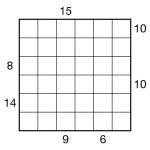

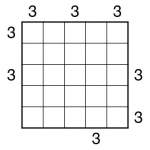
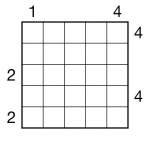
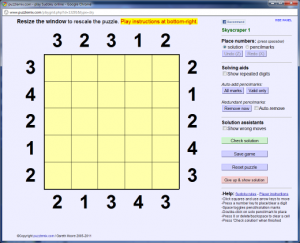
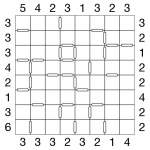
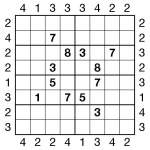
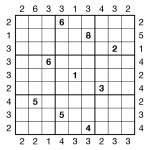

Recent Comments